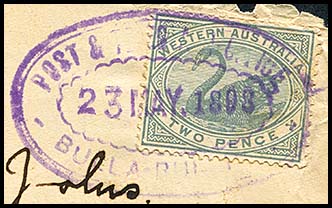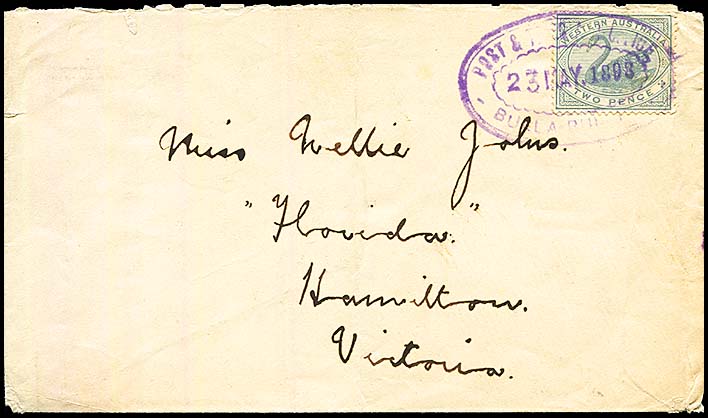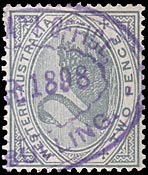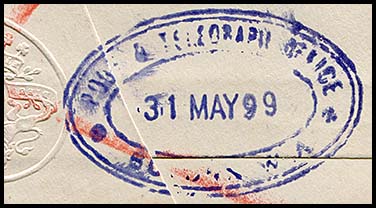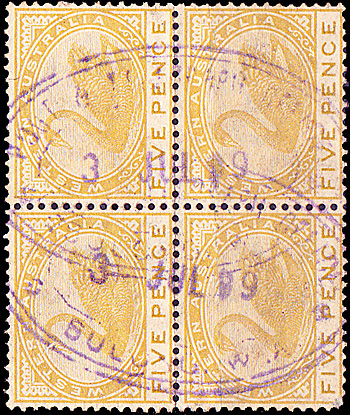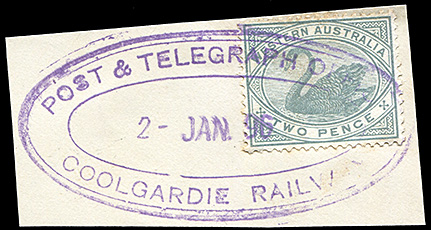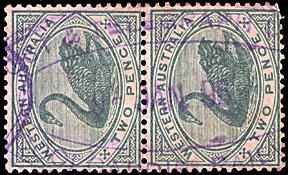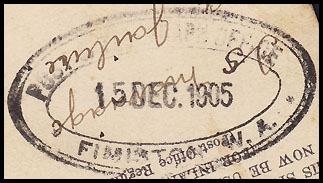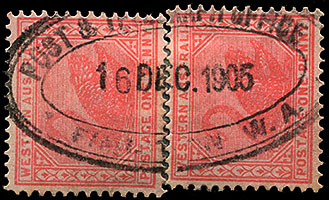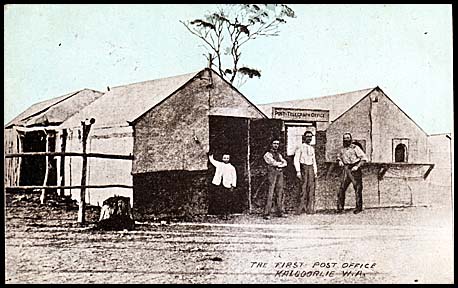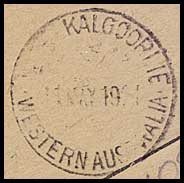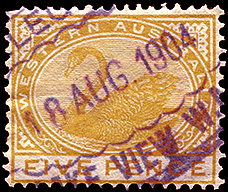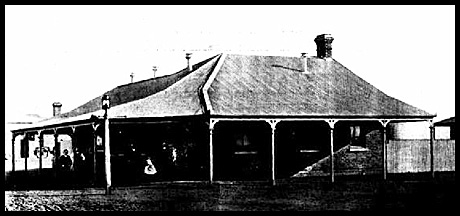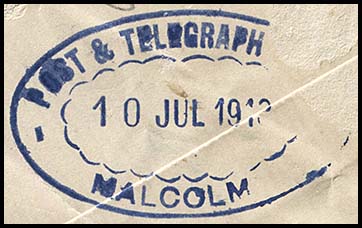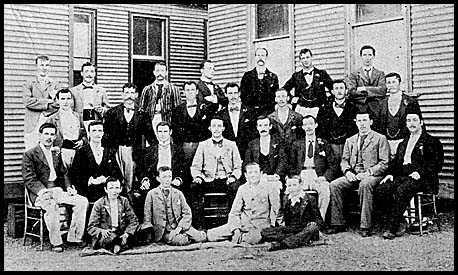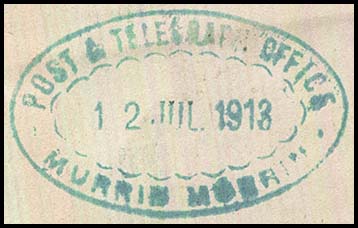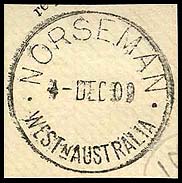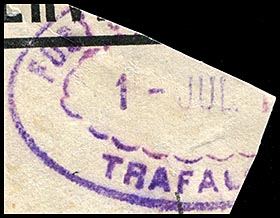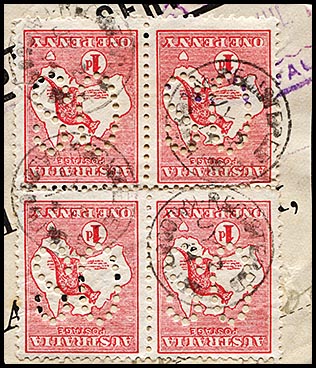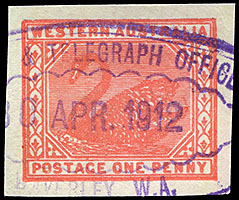Telegraph Offices in the Goldfields region.
- Home, index, site details
- Australia 1901-1988
- New South Wales
- Overview of NSW
- Telegraph lines
- Telegraph Offices
- Date stamps
- Forms
- Envelopes
- Rates
- Stamps
- Queensland
- Overview of Qld
- Telegraph lines
- Telegraph offices
- Date stamps
- Forms
- Envelopes
- Rates
- Stamps
- South Australia
- Overview of SA
- Telegraph lines
- Telegraph Offices
- Date stamps
- Forms
- Envelopes
- Rates
- Stamps
- Tasmania
- Overview of Tasmania
- General developments
- Reports
- Organisation
- Telegraph lines
- Telegraph Offices
- Date stamps
- Railway lines
- Forms
- Envelopes
- Rates
- Stamps
- Overview of Tasmania
- Victoria
- Overview of Vic.
- Telegraph lines
- Telegraph offices
- Date stamps
- Forms
- Envelopes
- Rates
- Stamps
- Ephemera
- Western Australia
- Overview of WA
- Telegraph lines
- Telegraph Offices
- Date stamps
- Forms
- Envelopes
- Rates
- Stamps
An aside comment on opening hours for various Telegraph Offices in the Goldfields is appended.
|
A Post and Telegraph Office was opened at Bardoc on 10 July 1896. It was downgraded to an Admnistrative Office on 1 August 1908. There is no record of a special date stamp for use with Telegraphs being allocated to this Office. Bardoc is situated between Kalgoorlie and Menzies along the Goldfields Highway - abut 45 kms (30 miles) from Kalgoorlie. The town's name is Aboriginal in origin and is taken from a hill close to town. The word barduk means near or close in the local dialect. |
|
|
A Post & Telegraph Office was opened on 6 December 1877. A Post Office had already been opened at Beverley on 1 May 1858. |
|
The Office was issued with a rubber oval POST & TELEGRAPH OFFICE date stamp (RO7-P&TO):
|
|
| Black Flag
On 10 July 1897, the Government Gazette listed amongst the reserves that had been set aside that included 7 acres in Black Flag for Police, Post and Telegraph, Warden's Office, public utility and the Weslean Church. The Post & Telegraph Office was opened on 18 July 1896 - presumably encompassing the previously listed area. The Office was closed on 4 April 1907 but re-opened on 1 July 1907 but then closed permanently on 24 February 1908. The two largest mines in the area - Black Flag and Lady Bountiful - had closed in 1906-1907 and so the town closed down soon after. |
||
The Office was issued with an rubber oval TELEGRAPH OFFICE date stamp:
|
 29 August 1896 - about six weeks after the P&T Office opened. |
|
|
A Post & Telegraph Office was opened at Bonnievale on 23 December 1897. It was downgraded to an Allowance Office on 1 September 1909. |
|
The Office was issued with a Post & Telegraph Office oval date stamp (RO6-P&TO):
|
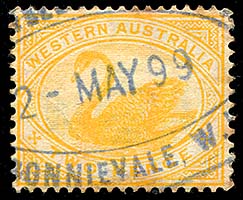 |
|
 16 March 1907. Detail of the oval on the cover below. |
3d red-brown registration envelope )indicium on reverse flap used from Bonnievale to Malhausen, Germany. Has
1d and 4d adhesives added on the front. On the reverse side, there is an oval "Registered/Perth, WA" date stamp in blue. |
|
| Boorabbin.
The Telegraph Office was opened on 24 September 1894. The Post & Telegraph Office was then opened in 1902. Boorabbin is about 65 miles (100 kms) north west of Coolgardie. |
|
The office was issued with a steel circular TELEGRAPH OFFICE date stamp.
|
 21 December 1912. Abacus June 2019, Lot 848. |
|
 10 August 1914. Prestige June 2009 Lot 160. |
| Boulder.
The Post & Telegraph Office was opened on 12 April 1897.
|
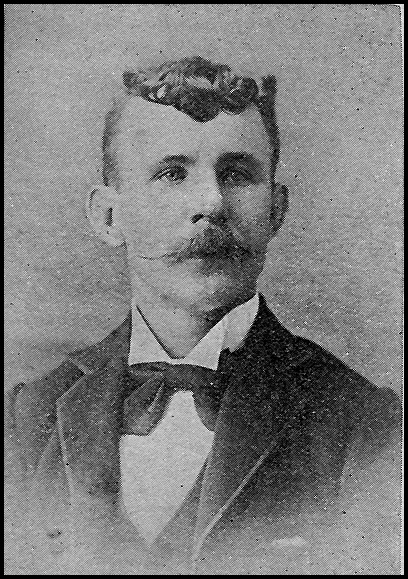 Mr. Dullory, Postmaster, Boulder. |
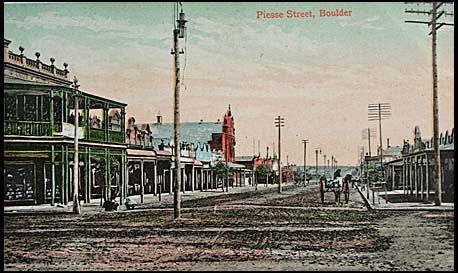 Boulder (Pleise Street) about 1900 showing telegraph poles. |
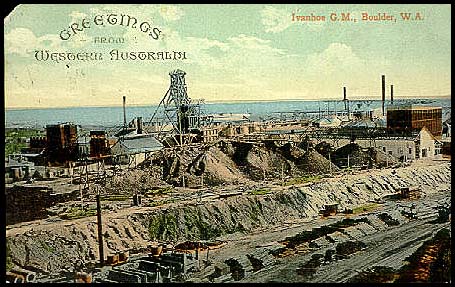 The Ivanhoe Gold Mine at Boulder about 1900. The Ivanhoe Gold Mine at Boulder about 1900. |
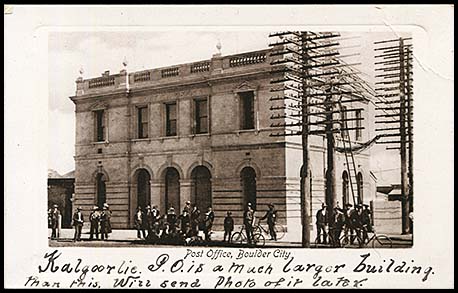 Boulder Post & Telegraph Office about 1900. See the reverse side of this postcard and further duscussion together with a rare Kalgoorlie oval date stamp elsewhere. |
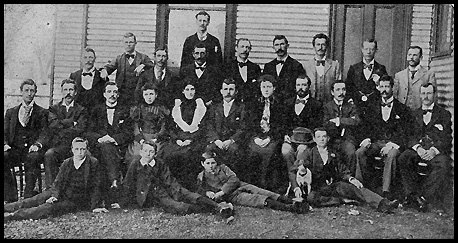 The staff at the Boulder Post, Telegraph and Telephone Office in 1897. Source: Souvenir of the Postal, Telegraph & Telephone Departments of Western Australia, Christmas 1896. |
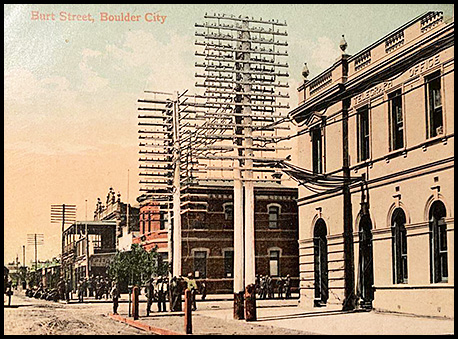 View of the Telegraph Office (on the right) in Burt Street, Boulder showing the telegraph wires.
|
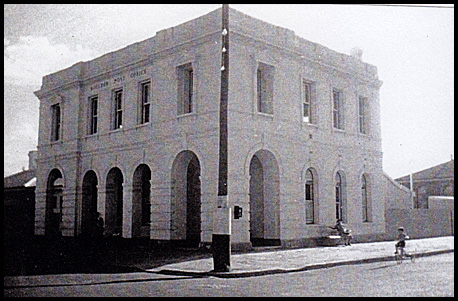 Boulder Post & Telegraph Office about 1950. |
The office was issued with four types of rubber oval office date stamp for use on telegrams. These were:
|
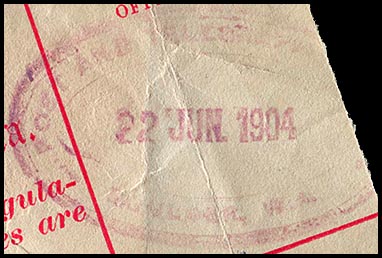 22 June 1904. |
|
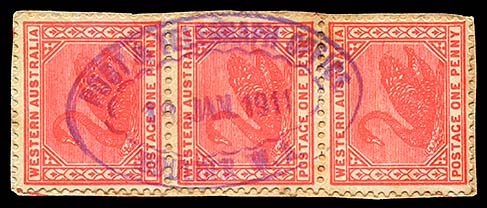 18 January 1911. |
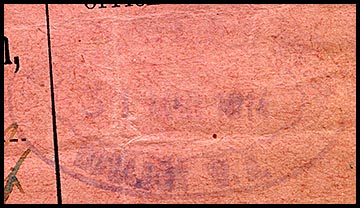 31 March 1914. Used on WI-DU-1. |
|
|
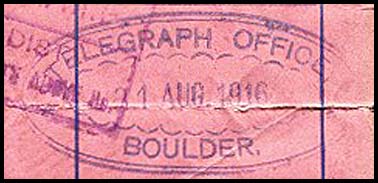 31 August 1916. Used on WI-DU-2.
|
Used 1944-47. |
|
Used: about 1976. |
| Broad Arrow.
Broad Arrow was established as the Kurawa Receiving Office on 16 July 1896. The name was changed to Broad Arrow when the Post & Telegraph Office was established in 1898.
The office was issued with two types of rubber oval POST & TELEGRAPH OFFICE date stamps. |
||
|
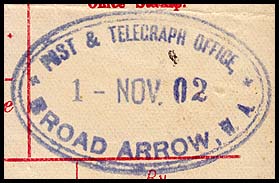 1 November 1902. Used on WC-DO-5B. |
|
|
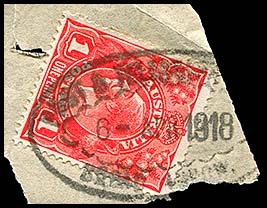 6 April 1918. |
|
| Coolgardie.
The Post & Telegraph Office opened on 22 July 1894. The original location of the Post Office - opened in September 1893 - is not known. The position of Messenger at the Coolgardie Telegraph Office (held by Mr. E. C. Harper) was abolished and gazetted on 5 August 1926. |
 The Coolgardie Post Office in which the Telegraph Office was temporarily located in 1894. Source: Souvenir of the Postal, Telegraph & Telephone Departments of Western Australia, Christmas 1896. |
| A new building was immediately planned.
The first section of Coolgardie's Public Buildings, which included the Post & Telegraph Office, was completed on 3 May 1895 at a cost of £7,060. There were mixed opinions of the design - the Coolgardie Miner of 31 March 1896 noting as follows:
The building was altered several times over the next few years. |
|
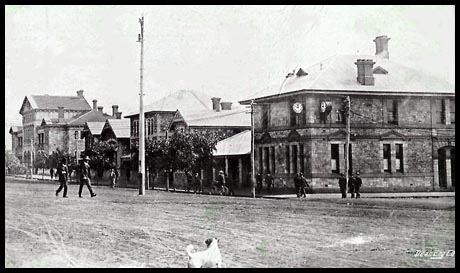 Coolgardie circa 1906. From a postcard. |
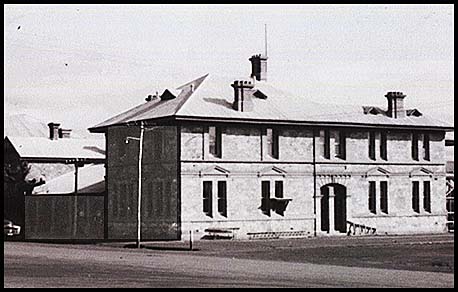 |
The Coolgadie Telegraph Office was issued with four types of rubber oval office date stamp which were used on telegrams between the early 1900s and the 1940s:
|
|
| On 6d bright violet Swan with Crown over CA watermark, perf 18 issued January 1893. | |
|
The Telegraph Office at the Coolgardie Railway station was also issued with an oval date stamp The Office opened in September 1895 and closed on 19 May 1896. The Western Mail of 13 March 1896 reported:
There are five recorded examples of the date stamp RO6 - P&TO - all used in early 1896 (rated RRRR) before the opening of the Railway Station. |
|
Prestige Philately August 2010 Lot 506. |
Previously considered that only this part strike existed. |
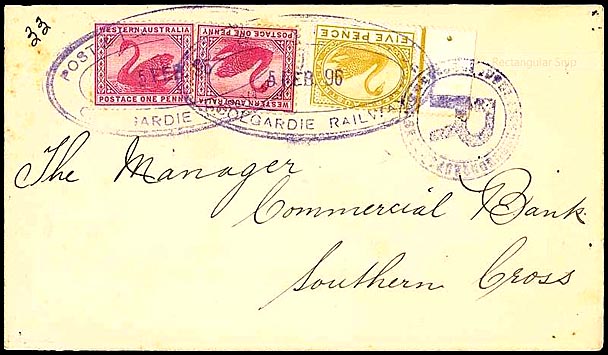 |
Coolgardie Railway Post & Telegraph Office. 5 February 1896. Double rate envelope registered to Southern Cross. Spink 19 May 2015, Vestey Collection Lot 485. |
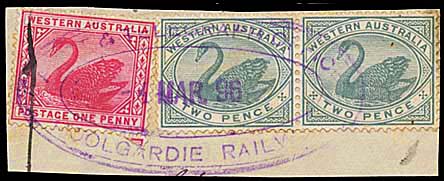 Coolgardie Railway Post & Telegraph Office. 4 March 1896. Prestige Philately August 2011 Lot 535. |
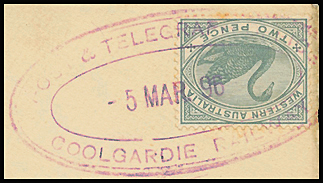 Coolgardie Railway Post & Telegraph Office. 5 March 1896. Prestige Philately December 2010 Lot 542. |
|
In the Goldfields, a Receiving Office was opened on 1 January 1995 25 miles from Kalgoorlie - and hence became known as 25 Mile. It was intended that this Office would be renamed Coonalion but instead it was renamed Kunnanalling on 15 November 1895. For further discussion and history of 25 Mile, 25 Miles Mines. A personal note written by Robin Goulder indicates that the Postmaster General's Annual Report for 1895 shows the spelling as Coonalion and that this spelling was also used in PMI. The 1896 Report shows the spelling as Kunanalling (late Coonalion). |
|
A RO6-P&TO oval date stamp was issued to the Office - presumably in 1895. It is incomplete and has the spelling as COONANALLI(NG). Goulder observes that the spelling in this date stamp "is more consistent with KUNANALLING and was presumably ordered before the name change. Either way, this is the first postal marking for Coonalion/Coonanalion".
|
 Undated. |
|
The mine is located about 30 kms north of Leonora. The town was later renamed Kurrajong. The Post & Telegraph Office opened on 17 July 1897 - two days after the line had been completed. It was then closed on 31 May 1901 but reopened as a Receiving Office on 17 June 1907. On 8 September 1897, the party who constructed the telegraph line to Lawlers (via Diorite King) passed through on their return to Coolgardie. Three hundred camels were expected through the following day on their return after taking loading to Lawlers. Snell Brothers of Menzies, had commenced the erection of a store - making the third in the town. |
|
The office was issued with a rubber oval POST & TELEGRAPH OFFICE date stamp (RO7-P&TO):
|
|
|
A Post & Telegraph Office was opened at Dundas (below Norseman) on 3 June 1896. Unfortunately the Office was destroyed by fire on 19 May 1895. A straight line DUNDAS handstamp is recorded but the date stamp was presumably destroyed in the fire. |
|
The Post & Telegraph Office opened on 26 November 1895 when 90 Mile changed name to Goongarrie. It had originally been named 90 mile because of its distance from Coolgardie. Gold was discovered in May 1893 by a prospector named Frost. |
|
Two rubber oval TELEGRAPH OFFICE date stamps were issued to the Goongarrie office:
|
 formerly 90 mile Torsten.jpg) 5 March 1896. |
 30 January 1897. |
|
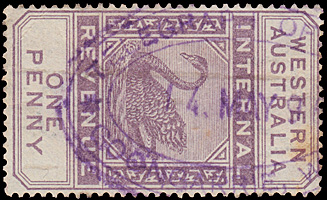 14 May 189?. |
|
|
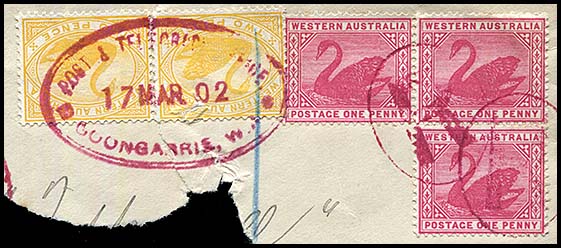 17 March 1902. |
Four rubber oval date stamps appear to have been issued to the Kalgoorlie Telegraph Office:
|
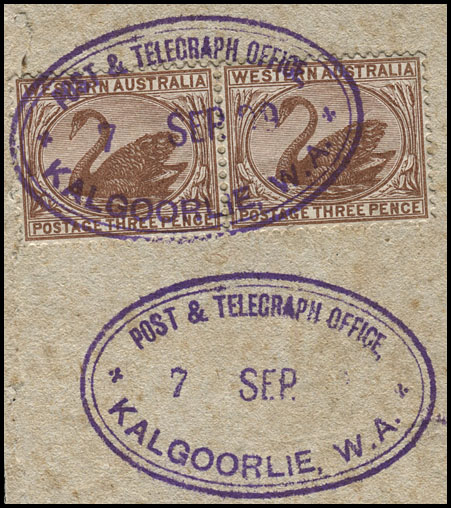 7 September 1899. Two strikes in violet of the RO2-P&TO date stamp. |
| The second example of the RO2-P&TO strike.
Double strike on a block of 6 1d red Swans. |
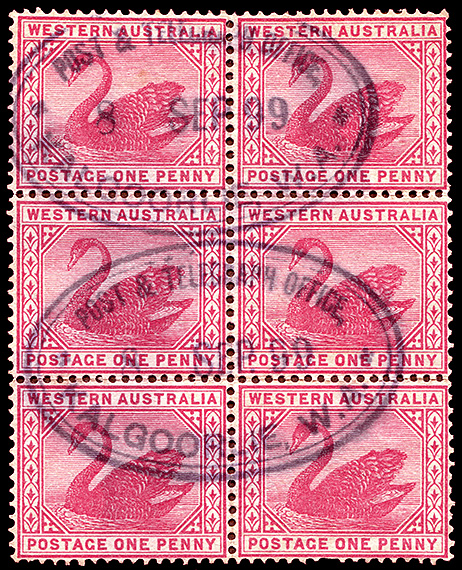 8 September 1899 - two strikes. ACE July 2018 Lot 932. |
|
 29 June 1903. Used on WI-DO-1. |
|
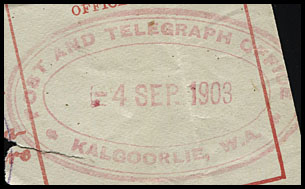 4 September 1903. |
|
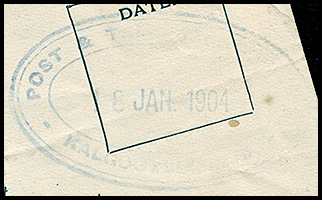 18 January 1904. Used on a Postal & Electric Telegraph Department receipt for telephone rental. |
|
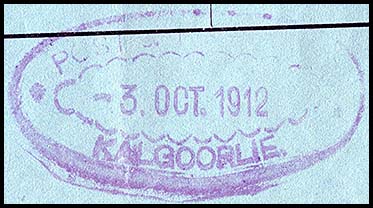 3 October 1912. |
|
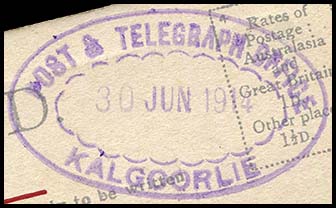 30 June 1914. |
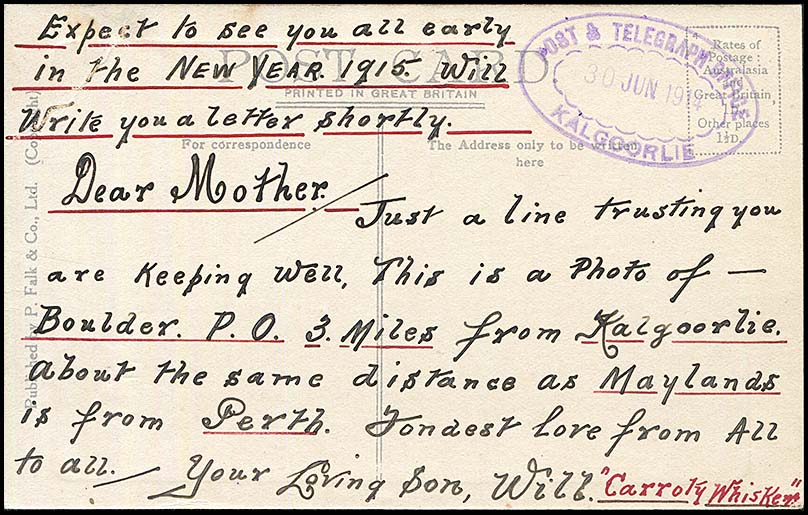 The reverse side of the postcard with the above RO4 - P&TO oval date stamp. The front of the card shows the Boulder Post Office with a comment comparing the two Post Offices. |
|
A steel date stamp inscribed TELEGRAPH OFFICE with KALGOORLIE W.A. at the base was issued to the Office:
A steel TELEGRAPHS date stamp has also been noted as being used in 1911 but it has not been seen (diameter 28 mm and rated RRRR). |
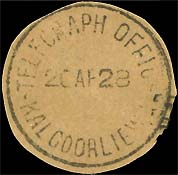 20 April 1928. |
 5 February 1931. |
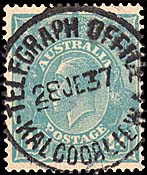 28 June 1937. |
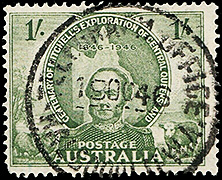 18 October 1946. |
|
A very rare date stamp is from North Kalgoorlie but with NORTH removed. That Post Office had operated in Ward Street and then in Campbell but closed on 21 June 1920. The date stamp had been used from 6 June 1906. The 28 mm date stamp is known only on two early telegrams (Rated RRRR). |
Used on AE-DO-1Eb (printed on the scarce brown paper instead of green). Also used on AE-DO-1Ea but it is a very smudged example. |
Kunanalling. See Coonanalion |
|
An Official Office was opened on 19 February 1904 when the office was transferred from Trafalgar which had been opened on 6 December 1902. The Office was transferred back to Trafalgar in 1909. The Lake View and Star Mine is located about 6 kms from Kalgoorlie. |
|
A rubber oval Telegraph Office date stamp (RO7-TO) was issued to the Office.
|
ACE Auctions, July 2018. |
|
The Post & Telegraph Office opened at Laverton on 13 August 1899. The site was originally known as British Flag. Two rubber oval date stamps were issued to the Telegraph Office at Laverton for use with telegraph business. They were used concurrently. |
|
|
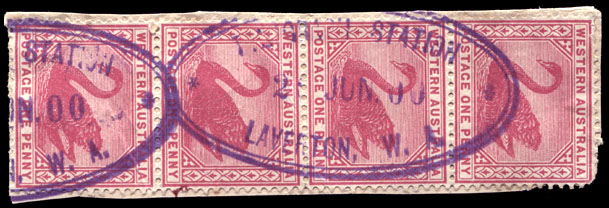 2? June 1900. |
 10 July 1900. ACE Stamp Auctions, December 2012. |
 21 July 1900. Spink Sale: 21 April 2017 in Lot 2143. |
Used: 26 September 1899 and 17 - 19 July 1900. |
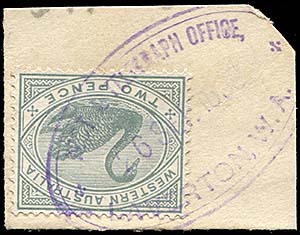
26 September 1899. (Earliest recorded date). |
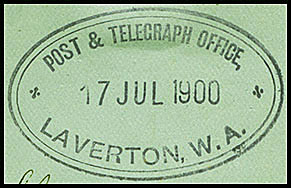 17 July 1900. |
 19 July 1900 (latest recorded date). |
|
The Post & Telegraph Office was opened on 30 August 1897. A Post Office had been opened during the previous year on 16 August 1896. |
|
Two rubber oval date stamps were issued to Lawlers for use with telegraphic business:
|
|
|
|
| Five formats for the oval date stamps issued to the Mount Leonora Telegraph Office are known. The first date stamp was inscribed Mount Leonora while the others (from 1900 onward) had the word MOUNT either removed or were produced as Leonora.
All had the inscription Post & Telegraph Office: |
|||
|
 10 March 1899. |
||
Also recorded:
|
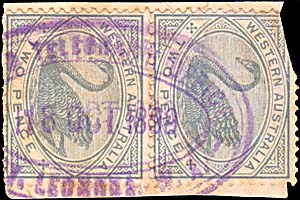 18 October 1899. |
||
Not recorded elsewhere. |
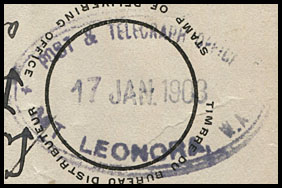 17 January 1902. Used on an Avis de Réception form. |
||
|
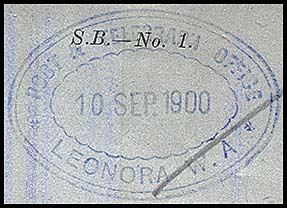 10 September 1900. |
||
|
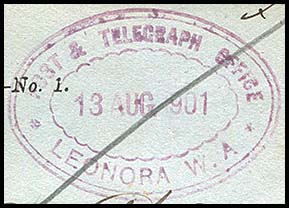 13 August 1901. |
||
|
 15 Jan ?? - maybe 1914. |
||
The Mount Leonora area was very rich. Crushing had started at the Sons of Gwalia mine on 1 May 1896 and, by 9 September 1897, 2,l51 tons had yielded 3,456 oz of gold. An interesting article appeared in The Evening Star (Boulder) on 3 September 1908:
The West Australian of 27 November 1908 reported:
|
| (Mt.) Malcolm.
A Receiving Office was opened at Mt. Malcolm on 1 March 1897. Soon after, the Post & Telegraph Office was opened on 15 June 1897 - also as Mount Malcolm. The Office was renamed Malcolm in 1904. It closed on 20 December 1950. The Office was issued with a rubber oval TELEGRAPH OFFICE date stamp (RO6-TO) inscribed Mt. Malcolm. Then, after the change of name, a new date stamp was issued inscribed Malcolm. |
|
|
 13 July 1897. |
 22 July 189?. |
 19 August 1897. |
|
 15 December 1897. |
|
Used on the reverse side of a registered OHMS envelope sent from Perth to Coolgardie and redirected to Murrin Murrin and then to the Dead Letter Office in Perth. The reverse side also has a similar RO4-P&TO date stamp in blue for Murrin Murrin. |
On 7 March 1896, the Kalgoorlie Miner reported that "Further results of crushings from the Little Wonder are to hand. The mine is situated about 15 miles from Doyles' Well, near Mount Malcolm. The first crushing of half a ton from the surface yielded 970 ounces of gold. A second crushing of 8cwt from the 70ft level gave 423 oz, and a third crushing from the 90ft level of 23cwt returned 1310 oz. The last crushing, which was from the 160 ft level, gave 250 oz from 48 cwt. Mount Malcolm is situated half-way between Ninety Mile and Lake Darlot or Lake Carey". On 19 March 1897, the Daily News reported that "A public meeting, attended by 700 persons in and around Mt. Malcolm, was held in front of the Mt. Malcolm Hotel in Star Street on Monday evening the 15th March ... (amongst other matters, the meeting urged) that the Government erect and open a Post and Telegraph office forthwith and that a bi-weekly mail service be established at once to this township".
|
|
On 11 August, 1896, an officer of the Telegraph Department arrived to install duplex instruments at the telegraph office. "The additions to the Menzies telegraph office have just been completed by the contractors Messrs. Hayward and Gray, and as a result the receiving operators were last night more comfortably situated. Instead of the postal and telegraphic work having to be done in one apartment, separate rooms have been provided in which the work of the different branches of the service can be carried out. This will undoubtedly prove advantageous to the public as well as the staff". (The Menzies Miner, 10 April, 1897). |
||
Four oval date stamps were issued for Telegraph use at Menzies with all of them used concurrently in 1904:
|
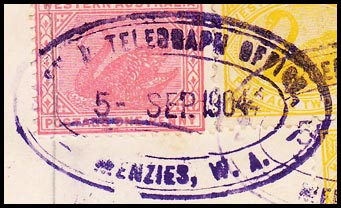 5 September 1904. |
|
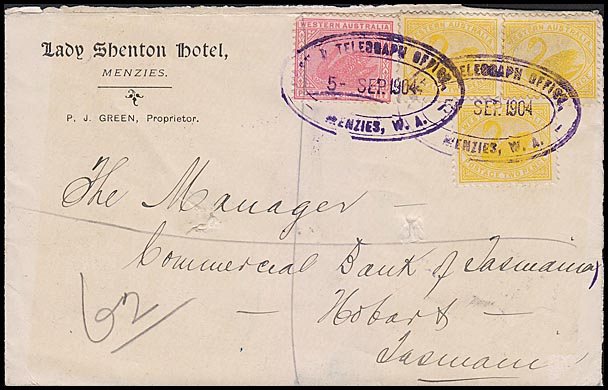 ACE Stamp Auctions November 2013 Lot 963.
ACE Stamp Auctions November 2013 Lot 963. |
Lady Shenton Hotel cover sent from Menzies to Hobart,Tasmania. 5 September 1904. Has two complete strikes of the Post & Telegraph Office oval date stamp (RO6 - P&TO).
|
|
|
 19 July 1904. |
|
|
 29 July 1904. Used on a Tattersall's cover to Hobart. |
|
|
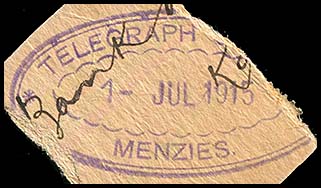 1 July 1915. |
|
|
|
|
A RO6-TO date stamp was issued to the Office.
|
 No date except 13 Ju?? |
|
Morgans (Mount Morgan) is east of Leonara on the way to Laverton. A Post & Telegraph Office was opened at Mount Morgan on 10 August 1899. It was renamed Morgans in 1909. |
|
One format of a rubber oval date stamp (RO2-P&TO) was issued to Mount Morgan.
|
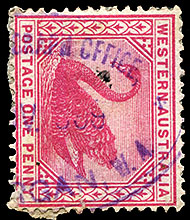 November 1899. |
Mulline and Mulwarrie The telegraph line had been completed in of before March 1901 to both places and to Davyhurst. Mr. Scholl (the Postmaster-General) said the Department was in the process of renting premises at both the first two locations. He hoped they would both be open very shortly and so operators would be appointed by that time (The Menzies Miner 6 April 1901). The office at Davyhurst would be deferred pending the receipt of a report. |
|
|
A Receiver of Mail Bags was opened in November 1897 and that was upgraded to the Murrin Murrin Post & Telegraph on 18 March 1898. It was downgraded to an Allowance Office on 23 October 1913. Two types of rubber oval date stamps were issued to the Office for use with telegraphic matters: |
|
|
 2 October 1899. |
This format had been referenced in several sources but no example has been seen until this one.
|
|
| Niagara.
The Post & Telegraph Office opened on 13 July 1896 after a Receiving Office had opened in January 1896. After being downgraded to an Allowance Office in 1907 and a Receiving Office in 1912, the office was closed on 7 July 1913. On 16 July 1896, the Coolgardie Miner had noted (at the time of opening of the lines) that "Another pressing need here is assistance for the local postmaster. A big mail comes in and it is the despatch office for four lines — altogether too much for one man. A decent post and telegraph office should also at once be erected, as a fair-sized mail bag and a small boy would just about crowd the present building". |
|
The Office was issued with a rubber oval POST & TELEGRAPH OFFICE date stamp (RO2-P&TO):
|
|
|
A RMB was opened at Paddington in November 1896 and this was converted to a Post & Telegraph Office on 15 November 1897. The Office was closed on 30 November 1911. The gold mine was located about half way between Kalgoorlie and Menzies. |
|
A rubber oval POST & TELEGRAPH OFFICE date stamp (RO2-P&TO) was issued to the office:
|
 Unknown date. |
|
A gold mine near Kalgoorlie and Coolgardie was named Lake View and soon became a small township. One of the main hotels in the town was the Trafalgar Hotel. On 6 December 1902, an Administrative Office was opened in Trafalgar - it is not known whether that office was in the Hotel (but it is highly probable). On 19 February 1904, this office was renamed Lake View but in 1909, the name reverted to Trafalgar. |
The Oval is on an O.H.M.S Savings Bank envelope. The block of 1d Kangaroos affixed over the top of the oval date stamp were cancelled the day after the Trafalgar date stamp was applied. |
Three 21 mm postal date stamps are known for Lake View but without known dates for usage. A number of 21 mm date stamps are known for Trafalgar (between 1904 and 1906) - yes confusing. A RO4-P&TO rubber oval date stamp is recorded as having been used:
|
|
|
The Telegraph Office opened on 18 October 1896. Mr G. Ferguson was appointed as the first Post & Telegraph Master. Widgemooltha is about 55 miles (80 kms) south of Coolgardie.
|
||
A rubber oval Post & Telegraph Office date stamp (RO2 - P&TO) was issued for use with telegraphs:
|
 6 January ??. In red. |
|
|
A Receiver of Mail Bags was opened in February 1896 and a Post & Telegraph Office was opened on 16 February 1897. That office was closed on 31 December 1899. Yerilla is just east of Kalgoorlie. |
|
The Office was issued with a Post & Telegraph rubber oval date stamp. Used in purple: 8 September 1899. Size:Size: 29 × 45 mm (e = 0.76). Rated: RRRR. Number in the Census: 1.
|
 8 September 1899 - about 3 months prior to Office closing. |
|
A Post & Telegraph Office was first opened at The Granites on 10 December 1900. During the visit of the Warden on 3 December 1900, it was agreed that the name The Granites was not sufficiently reassuring for a gold mining centre and so it should be changed. The Warden suggested that, if a local aboriginal name could be found, bearing a suitable English interpretation it would help the local nomenclature and prove acceptable in many other ways. After several suggestions, the name Yundamindera was selected and soon gazetted. Hence the office was renamed Yundamindera from The Granites. The article in the North Coolgardie Herald of 13 December 1900 reported that "The Post and Telegraph Offices shall remain upon the site where they were started to be erected. The work has gone on rapidly since instructions to that effect were received and we expect to be able to do business in the building by the end of the current week". On 13 June 1903, the Laverton & Beria Mercury reported that "Mr. C. Cooper, of the local Post and Telegraph Office, who recently spent a week or two in the Laverton Hospital suffering from pneumonia and who is at present recuperating his health at Mandurah, has received instructions to proceed to Yundamindera at the termination of his vacation to take charge of the Post and Telegraph Office at that place. His many friends in Laverton wish him every success". |
||
The RO6-P&TO date stamp issued to the Office:
|
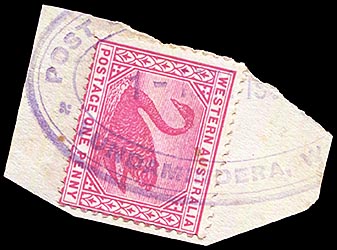 1 May 190? |
|
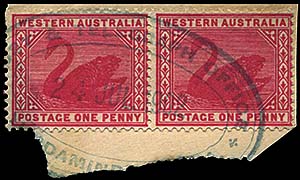 24 July 1902. |
||


